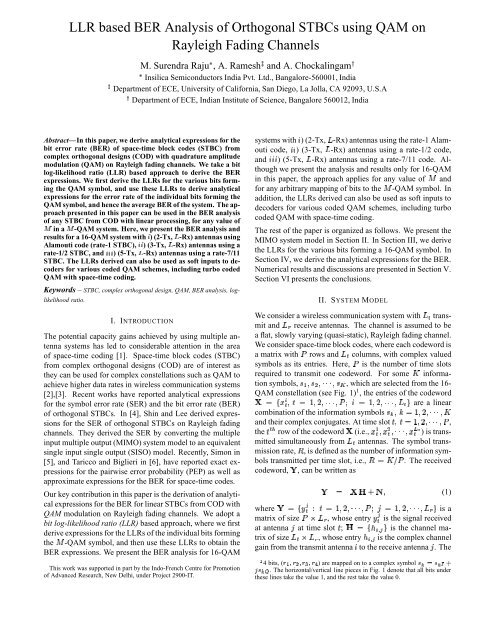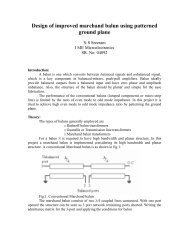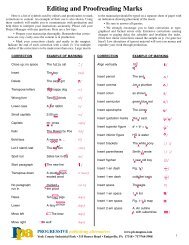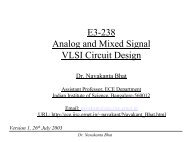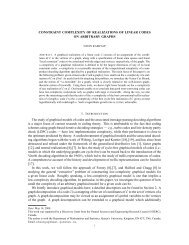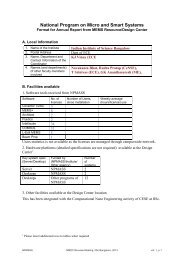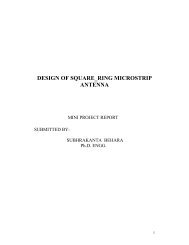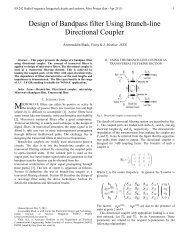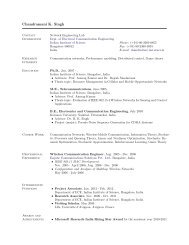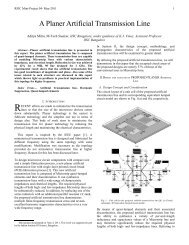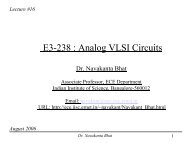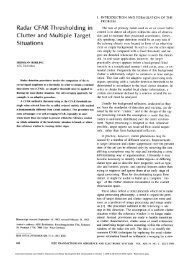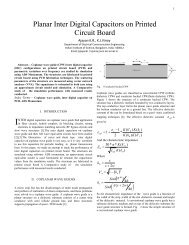LLR based BER Analysis of Orthogonal STBCs using QAM on ...
LLR based BER Analysis of Orthogonal STBCs using QAM on ...
LLR based BER Analysis of Orthogonal STBCs using QAM on ...
Create successful ePaper yourself
Turn your PDF publications into a flip-book with our unique Google optimized e-Paper software.
"!"+=Z m´Ð [—-1g @ " ( d 5+£G"G5+ %"¤¤¤¤¤¤¤¥G 5+g @ (ÛÊÑ¦Û ÑÊ££ £ ££ ££ £££££ ©§§§§§§§5""Û"A"%¤£¤¤¤¤¤¤¤¤¤¤¤¤¤¤¤¥£ £ Û £ Ê ££ £ Ê£££££££ÊÛ££ Ñ Ñ . Ê Û¹¢P¤P¥" %£5¹¢Q*¤Q¥"£%££ £ § ¦ §§©+§§§§§§§§§§§§"§"""10 −1Average Probability <str<strong>on</strong>g>of</str<strong>on</strong>g> Bit Error10 −210 −310 0 Average SNR per bit (dB)C ¦ÛÑ£¦Û . ÑÑ ÑC Û ÑÊ ÑÑ. ÑSimulated <str<strong>on</strong>g>BER</str<strong>on</strong>g> <str<strong>on</strong>g>using</str<strong>on</strong>g> True <str<strong>on</strong>g>LLR</str<strong>on</strong>g>’s, 2Tx, 2Rx antennasAnalytical <str<strong>on</strong>g>BER</str<strong>on</strong>g> <str<strong>on</strong>g>using</str<strong>on</strong>g> apprx. <str<strong>on</strong>g>LLR</str<strong>on</strong>g>s, 2Tx, 2 Rx antennasSimulated <str<strong>on</strong>g>BER</str<strong>on</strong>g> <str<strong>on</strong>g>using</str<strong>on</strong>g> True <str<strong>on</strong>g>LLR</str<strong>on</strong>g>s, 2Tx, 1 Rx antennasAnalytical <str<strong>on</strong>g>BER</str<strong>on</strong>g> <str<strong>on</strong>g>using</str<strong>on</strong>g> apprx. <str<strong>on</strong>g>LLR</str<strong>on</strong>g>s, 2Tx, 1 Rx antennasÑ. Ñ . 10 −40 5 10 15ÑÑFig. 2. Comparis<strong>on</strong> <str<strong>on</strong>g>of</str<strong>on</strong>g> the analytical <str<strong>on</strong>g>BER</str<strong>on</strong>g> evaluated <str<strong>on</strong>g>using</str<strong>on</strong>g> approximate<str<strong>on</strong>g>LLR</str<strong>on</strong>g>s vs the simulated <str<strong>on</strong>g>BER</str<strong>on</strong>g> <str<strong>on</strong>g>using</str<strong>on</strong>g> the <str<strong>on</strong>g>LLR</str<strong>on</strong>g>s without approximati<strong>on</strong>. 16-<str<strong>on</strong>g>QAM</str<strong>on</strong>g> with rate-1 STBC (Alamouti code). 2Tx/2Rx and 2Tx/1Rx antennas., andis the well known Alamouti code with parameters," + >> is a - UJ- diag<strong>on</strong>al matrixwith ¹¢© diag<strong>on</strong>al element, ¥, <str<strong>on</strong>g>of</str<strong>on</strong>g> the - @¥
10 −110 −1Average Probability <str<strong>on</strong>g>of</str<strong>on</strong>g> Bit Error10 −210 −310 −410 0 γ b(dB)No Diversity2Tx, 1Rx2Tx, 2Rx2Tx, 4Rx2Tx, 10RxAverage Probability <str<strong>on</strong>g>of</str<strong>on</strong>g> Bit Error10 −210 −310 −410 0 γ b(dB)No Diversity3Tx, 1Rx3Tx, 2Rx3Tx, 4Rx3Tx, 10Rx10 −50 2 4 6 8 10 12 14Fig. 3. <str<strong>on</strong>g>BER</str<strong>on</strong>g> performance <str<strong>on</strong>g>of</str<strong>on</strong>g> 16-<str<strong>on</strong>g>QAM</str<strong>on</strong>g> with 2 transmit antennas V e¡ _£¢_¥¤_ ¡§¦andreceive antennas <str<strong>on</strong>g>using</str<strong>on</strong>g> rate-1 STBC (Alamouti code).Fig. 4.10 −50 2 4 6 8 10 12 14<str<strong>on</strong>g>BER</str<strong>on</strong>g> performance <str<strong>on</strong>g>of</str<strong>on</strong>g> 16-<str<strong>on</strong>g>QAM</str<strong>on</strong>g> with 3 transmit antennas V e andreceive antennas <str<strong>on</strong>g>using</str<strong>on</strong>g> rate-1/2 STBC.¡ _¥¢_£¤_ ¡§¦<str<strong>on</strong>g>of</str<strong>on</strong>g> the individual bits forming the <str<strong>on</strong>g>QAM</str<strong>on</strong>g> symbol, and hencethe average <str<strong>on</strong>g>BER</str<strong>on</strong>g> <str<strong>on</strong>g>of</str<strong>on</strong>g> the system. Although the analysis wasgiven <strong>on</strong>ly for 16-<str<strong>on</strong>g>QAM</str<strong>on</strong>g> in this paper, the approach appliesto the <str<strong>on</strong>g>BER</str<strong>on</strong>g> analysis <str<strong>on</strong>g>of</str<strong>on</strong>g> -<str<strong>on</strong>g>QAM</str<strong>on</strong>g> systems for any value <str<strong>on</strong>g>of</str<strong>on</strong>g>(any arbitrary mapping <str<strong>on</strong>g>of</str<strong>on</strong>g> bits to <str<strong>on</strong>g>QAM</str<strong>on</strong>g> symbols) for anySTBC from COD with linear processing. We presented theanalytical <str<strong>on</strong>g>BER</str<strong>on</strong>g> results for 16-<str<strong>on</strong>g>QAM</str<strong>on</strong>g> with ) (2-Tx, -Rx) antennas<str<strong>on</strong>g>using</str<strong>on</strong>g> Alamouti code (rate-1 STBC), ) (3-Tx, -Rx)antennas <str<strong>on</strong>g>using</str<strong>on</strong>g> a rate-1/2 STBC and ) (5-Tx, -Rx) antennas<str<strong>on</strong>g>using</str<strong>on</strong>g> a rate-7/11 STBC. The <str<strong>on</strong>g>LLR</str<strong>on</strong>g>s derived can alsobe used as s<str<strong>on</strong>g>of</str<strong>on</strong>g>t inputs to decoders for various coded <str<strong>on</strong>g>QAM</str<strong>on</strong>g>schemes, including turbo coded <str<strong>on</strong>g>QAM</str<strong>on</strong>g> with space-time coding.Average Probability <str<strong>on</strong>g>of</str<strong>on</strong>g> Bit Error10 −110 −210 −310 −410 −5No Diversity5Tx, 1 Rx5Tx, 2Rx5Tx, 4Rx5Tx, 10Rx10 0 γ b(dB)REFERENCES[1] G. J. Foschini and M. J. Gans, “On limits <str<strong>on</strong>g>of</str<strong>on</strong>g> wireless communicati<strong>on</strong>sin a fading envir<strong>on</strong>ment when <str<strong>on</strong>g>using</str<strong>on</strong>g> multiple antennas,” Wireless Pers.Commun., vol. 6, pp. 311–335, 1998.[2] V. Tarokh, H. Jafarkhani, and A. R. Calderbank, “Space-time blockcoding for wireless communicati<strong>on</strong>s: Performance results,” IEEE Jl.Sel. Areas in Commun., vol. 17, no. 3, pp. 451–460, 1999.[3] W. Su and X.-G. Xia, “On space-time block codes from complex orthog<strong>on</strong>aldesigns,” Wireless Pers. Commun., vol. 25, no. 1, pp.1-26,April 2003.[4] H. Shin and J. H. Lee, “Exact symbol error probability<str<strong>on</strong>g>of</str<strong>on</strong>g> orthog<strong>on</strong>al space-time block codes,”http://cctlab01.snu.ac.kr/nrl/c<strong>on</strong>ference/no1547.pdf[5] M. K. Sim<strong>on</strong>, “Evaluati<strong>on</strong> <str<strong>on</strong>g>of</str<strong>on</strong>g> average bit error probability for spacetime coding <str<strong>on</strong>g>based</str<strong>on</strong>g> <strong>on</strong> a simpler exact evaluati<strong>on</strong> <str<strong>on</strong>g>of</str<strong>on</strong>g> pairwise error probability,”Jl. Commun. Networks, vol. 3, no. 3, September 2001.[6] G. Taricco and E. Biglieri, “Exact pairwise error probability <str<strong>on</strong>g>of</str<strong>on</strong>g> spacetimecodes,” IEEE Trans. Inform. Theory, vol. 48, pp. 510–513, February2002.[7] S. M. Alamouti, “A simple transmit diversity technique for wirelesscommunicati<strong>on</strong>s,” IEEE Jl. Sel. Areas in Commun., vol. 16, no. 8, pp.1451–1458, October 1998.[8] R. Pyndiah, A. Picard and A. Glavieux, “Performance <str<strong>on</strong>g>of</str<strong>on</strong>g> block turbocoded 16-<str<strong>on</strong>g>QAM</str<strong>on</strong>g> and 64-<str<strong>on</strong>g>QAM</str<strong>on</strong>g> modulati<strong>on</strong>s,” Proc. IEEE GLOBE-COM’95, pp. 1039–1043, Singapore, November 1995.[9] A. J. Viterbi, “An intuitive justificati<strong>on</strong> and a simplified implementati<strong>on</strong><str<strong>on</strong>g>of</str<strong>on</strong>g> the MAP decoder for c<strong>on</strong>voluti<strong>on</strong>al codes,” IEEE Jl. Sel. Areas inCommun., vol. 16, no. 2, pp. 260–264, 1998.[10] J. W. Craig, “A new, simple and exact result for calculating the probability<str<strong>on</strong>g>of</str<strong>on</strong>g> error for two-dimensi<strong>on</strong>al signal c<strong>on</strong>stellati<strong>on</strong>s,” Proc. IEEEMILCOM’91, pp. 571–575, 1991.10 −60 2 4 6 8 10 12 14Fig. 5. <str<strong>on</strong>g>BER</str<strong>on</strong>g> performance <str<strong>on</strong>g>of</str<strong>on</strong>g> 16-<str<strong>on</strong>g>QAM</str<strong>on</strong>g> with 5 transmit antennas V e¡ _¥¢_£¤_ ¡§¦andFig. 6.Average Probability <str<strong>on</strong>g>of</str<strong>on</strong>g> Bit Errorreceive antennas <str<strong>on</strong>g>using</str<strong>on</strong>g> rate-7/11 STBC.10 010 −110 −210 −310 −4No diversity (1Tx, 1Rx)2Tx, 2Rx, Alamouti code3Tx, 2Rx Scheme (rate−1/2)5Tx, 2Rx Scheme (rate−7/11)10 −5AWGN10 −60 2 4 6 8 10 12 14γ b(dB)<str<strong>on</strong>g>BER</str<strong>on</strong>g> performance <str<strong>on</strong>g>of</str<strong>on</strong>g> 16-<str<strong>on</strong>g>QAM</str<strong>on</strong>g> with different <str<strong>on</strong>g>STBCs</str<strong>on</strong>g> –)2Tx antennas<str<strong>on</strong>g>using</str<strong>on</strong>g> rate-1 STBC (Alamouti code),) 3 Tx antennas <str<strong>on</strong>g>using</str<strong>on</strong>g> rate-1/2STBC,)5Tx antennas <str<strong>on</strong>g>using</str<strong>on</strong>g> rate-7/11 STBC. Number <str<strong>on</strong>g>of</str<strong>on</strong>g> receive antennas,` e ¢ .


